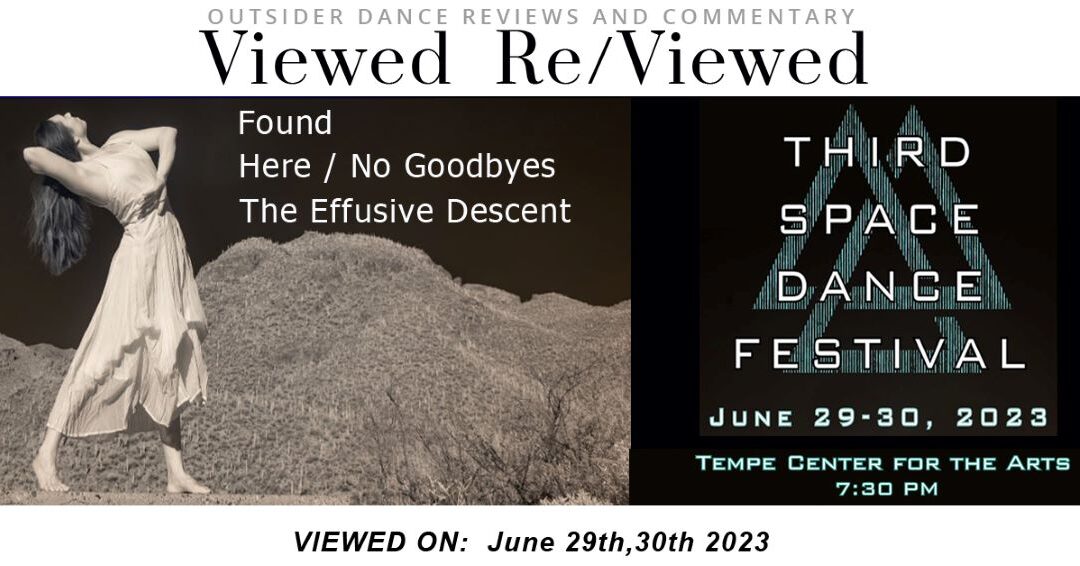Choreographer: Keith A. Thompson
Company: danceTactics performance group
Performers: Shawn Brush, Aidan Feldman
The published program for this piece did not provide any insights into its intent, origin or content, other than a lengthy (and impressive) bio of the choreographer Keith A. Thompson. A subsequent conversation with one of the performers provided some elucidation. This apparently consists of two excerpts from a larger work based on source material of which the second movement’s narrative is a part – the loss of a lover through aids. That insight provided some much-needed perspective, as it linked the first and second movements for me in a way that was not immediately apparent.
Both the first and second movement were performed by an admirably paired male duo. While the first movement was touching and credible, I see it, particularly in hindsight, as essentially a necessary preamble, establishing the depth of connection between the two characters. The dramatic heart of this work, at least in the segments presented, lies in the second movement, and that is the part I am most eager to address, especially since it is driven by a spoken word soundtrack.
Dancers and choreographers can be attracted to spoken word for all the reasons that a particular narrative can appeal to us. But blending two art forms is fraught with pitfalls. The dancer’s body is natively attuned to music and rhythm. Adding or substituting narrative throws that same body into the great unknown and results in far more failures than success. Either the movement is so disassociated from the message as to make both incomprehensible, or there is a mawkish slavery to the text that turns the dancer into a mime. Keeping the dance performance somehow connected to, but distinct from, the narrative, requires constant artistic interpretation, creating a synergy that elevates both the message and the movement. There is a powerful incentive to attempt this, but quite honestly, I have seen, at most, three or four presentations that I thought were successful and the last one was performed by Pilobolus. It isn’t easy.
What I thought was particularly challenging about this piece was the specificity of the narrative – all the sensory detail referring to smell and touch that would natively invite some form of mimicry from the performers. However, this performance was jazz. If the spoken word was the melody, then the movement contained all the notes around it that expanded on that narrative and let us experience it from unexpected angles.
The author of the text related a heart-rending recollection of profound attachment and the expectation of loss. But the actual performance defied easy categorization or projection. In particular, the performers switched seamlessly between the survivor and the one departing. As an audience, we are inclined to identify with a character, but this belied our expectations, thwarted our projections and forced us to be constantly aware of the moment – where anyone could be anyone or everyone and the distinction between the comforting and the comforted, the grieving and the grieved were blurred and ultimately lost. While we may have been tempted to identify with one or the other, instead we experienced both – and the work became much more impactful and significant because of it.
In addressing this material, I feel that choreographer Thompson honored the source while giving it another dimension through the magic and the mystery of movement. This is an all-too-rare example of a successful creative synergy between movement and the spoken word. For me, it acknowledged the fundamental nature of movement in that process – and here I must disclose my bias. As a writer, I am quick to acknowledge the inadequacy of language. I once said “only the body can express the ephemeral” and I still believe that. The body is a vast, mysterious repository that can simultaneously contain disparate emotions – emotions that the intractable filters in the conscious mind can only imperfectly access and partially express. To put it another way, we can experience powerful, conflicting states simultaneously, deep in our bones, but that complexity, when it rises to our awareness, is inexpressible in language delivered one word at a time. And the reverse is also true. A single word can trigger a cascade of emotions throughout the physical core of our being. There are no rules or criteria to navigate this quest for a melding of these elements, the physical and intellectual, that define our humanity. All we have is art.
That is how I perceived the multitude of emotions I felt in the second movement of Here / No Goodbyes – this is art.
Since this is an excerpt (I think two separate excerpts, really) I have no idea what the larger vision or program might be. But the approach and execution displayed here indicates that choreographer/creator Keith A. Thompson has a sure command of the source material and the artistic integrity to treat it creatively. Be its final form dance, movie or opera, I hope that Thompson finds a venue accessible to us all so that we can view it as he ultimately envisions the completed work.
Viewed Re/Viewed


Recent Comments